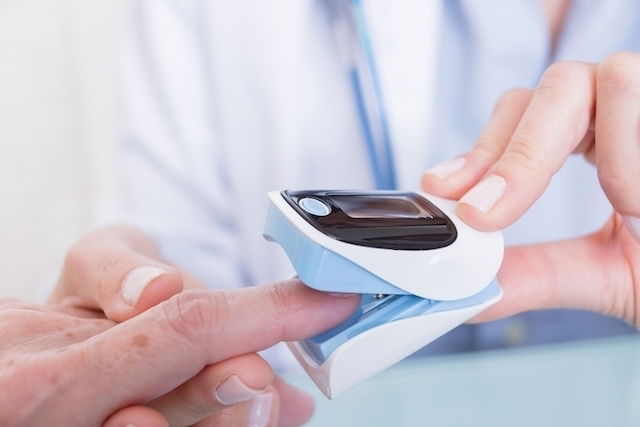Pulse oxymetry is measured using a small device that is generally placed on the tip of the finger. It allows you to measure saturation, which is the amount of oxygen circulating in the blood at a given time.
Typically, an oximeter is used to check low oxygen levels, which can be caused by conditions that impair or interfere with oxygenation in the body, like heart disease, lung problems or neurological diseases.
A saturation above 95% is considered to be normal and indicates that the blood is carrying optimal amounts of oxygen. A saturation rate below this value may indicate that the lungs are not working properly and that oxygen therapy may be required.

How to use a pulse oximeter
To use a pulse oximeter correctly, you should:
- Turn on the device until it starts to emit a red light
- Place the device on the tip of your finger, so that the red light is above the fingernail
- Keep your hand relaxed and supported, below heart level;
- Wait a few seconds until the saturation value appears on the device screen
To ensure a good reading, it is also important that your hands are not too cold (as this reduces blood circulation and impairs the device's reading). You should also remove nail polish or fake nails and avoid using the device in very bright or sunny environments.
In cases where it is not possible to measure saturation on the finger, the oximeter can be used on the toes or earlobe.
Normal levels
A healthy person with adequate oxygenation usually has an oxygen saturation above 95%, however, it is common for mild conditions, such as flu or colds, to cause dips in saturation between 93-95%. These are not a cause for clinical concern in this context.
Oxygen levels below 90% may be a sign of low oxygen supply due to serious condition, like asthma, pneumonia, emphysema, heart failure, neurological diseases or even complications from COVID-19.
How the pulse oximeter works
The finger pulse oximeter has a light sensor that is able to measure the concentration of oxygen found in the blood circulating beneath the sensor. This sensor takes real-time, immediate measurements, and can also be kept on your finger for continuous monitoring.
How to read a pulse oximeter
The main purpose of the pulse oximeter is to measure oxygen saturation, which is reported on the screen, in the field that says "SpO2". The value is usually a percentage, and is generally a number over 90.
However, most devices will also show the heart rate, which is found in the HR field and reported as bpm (beats per minute).
Can smoking affect the result?
Smokers who use a pulse oximeter may have an incorrect oxygen saturation reading. This happens because the device is not able to distinguish between cells that carry oxygen and those that carry carbon dioxide. Since smokers tend to have higher levels of carbon dioxide, it is possible that the value shown by the pulse oximeter is falsely high, even if the amount of oxygen is actually low.
If there is a suspicion that a smoker's saturation value is not correct, especially if there are signs of respiratory difficulty, such as shortness of breath, easy fatigue, pale skin or bluish lips, it is important to go to the hospital for blood work, specifically an arterial blood gas analysis. This blood test can accurately measure the correct oxygen and carbon dioxide values.






























